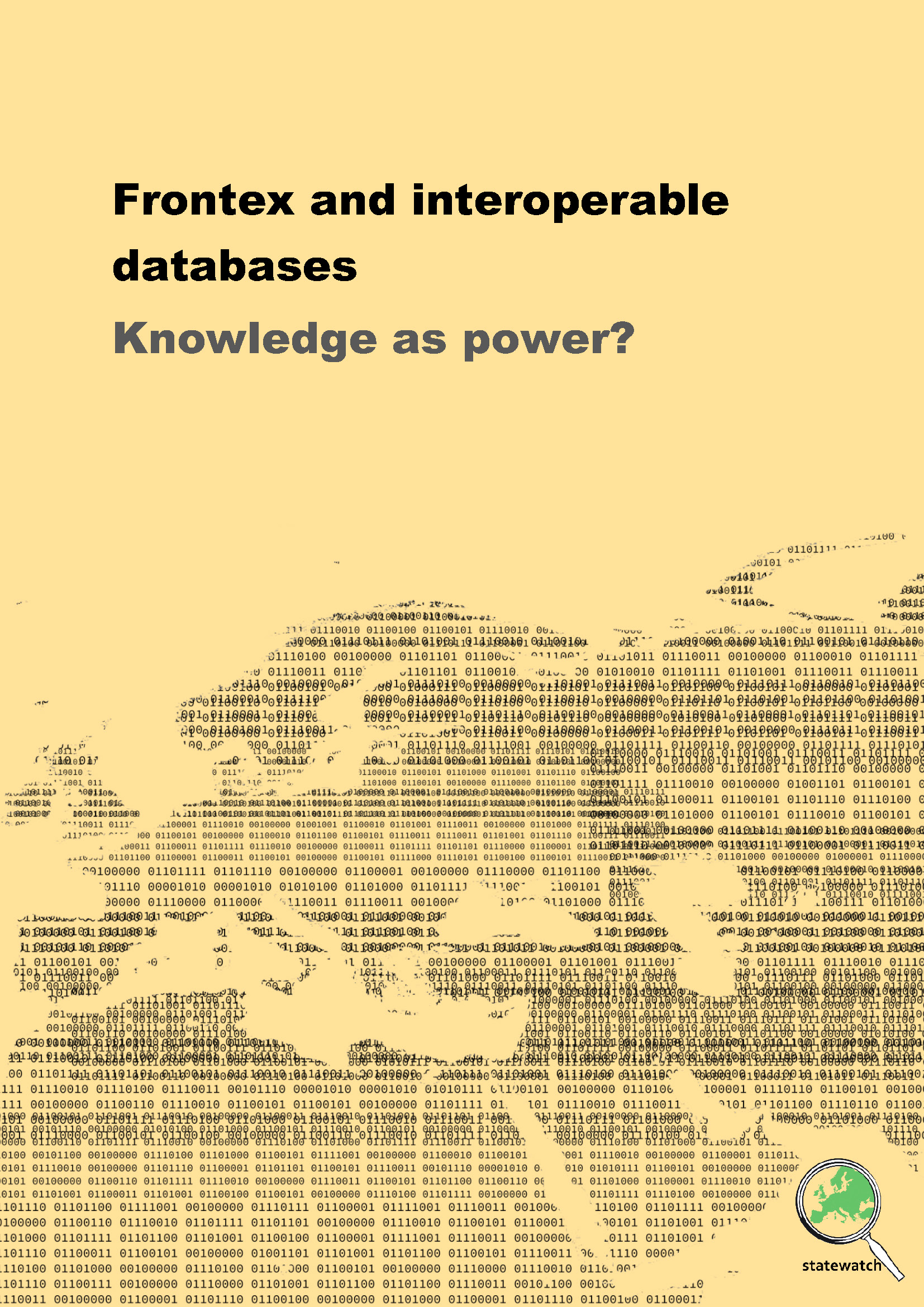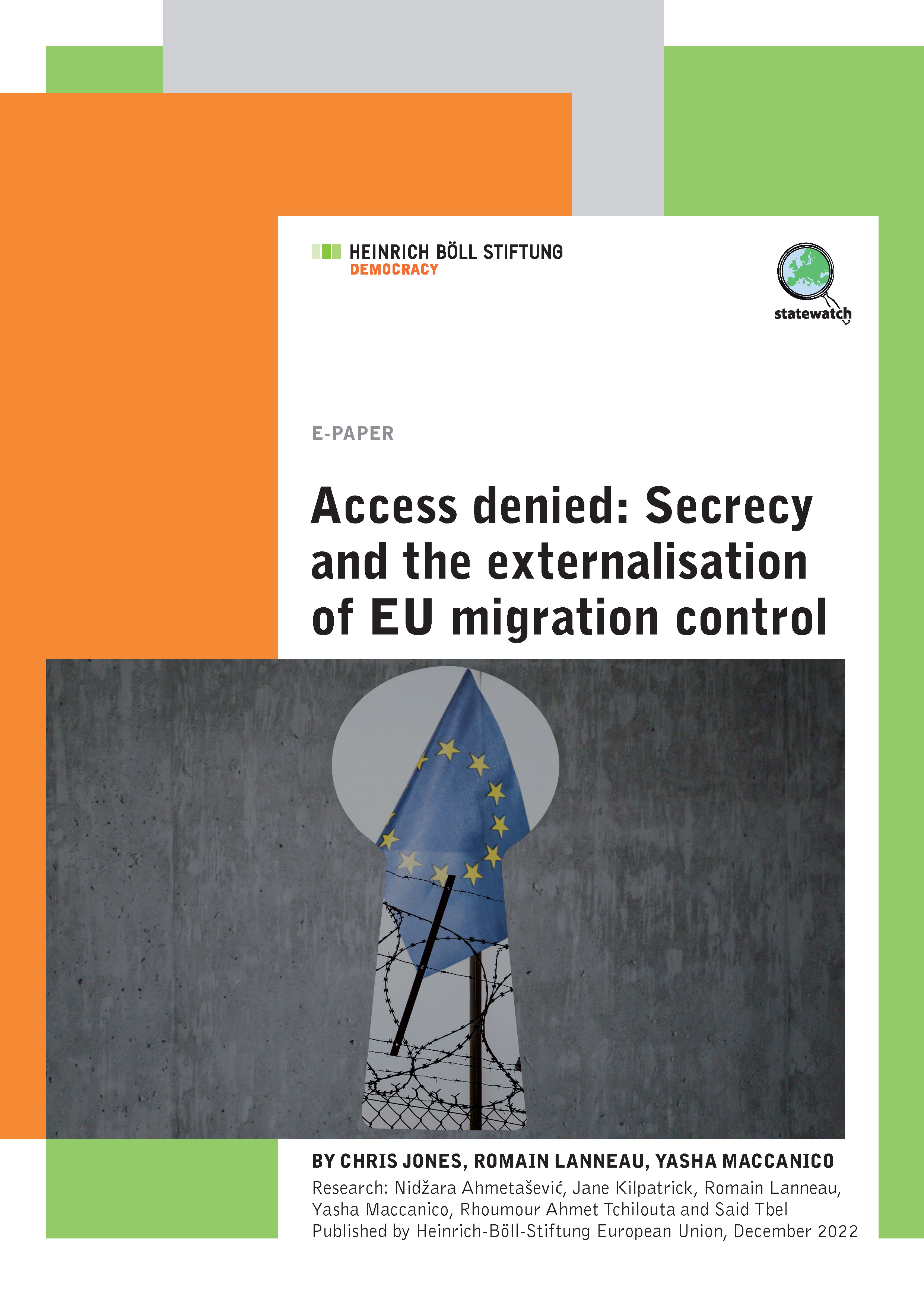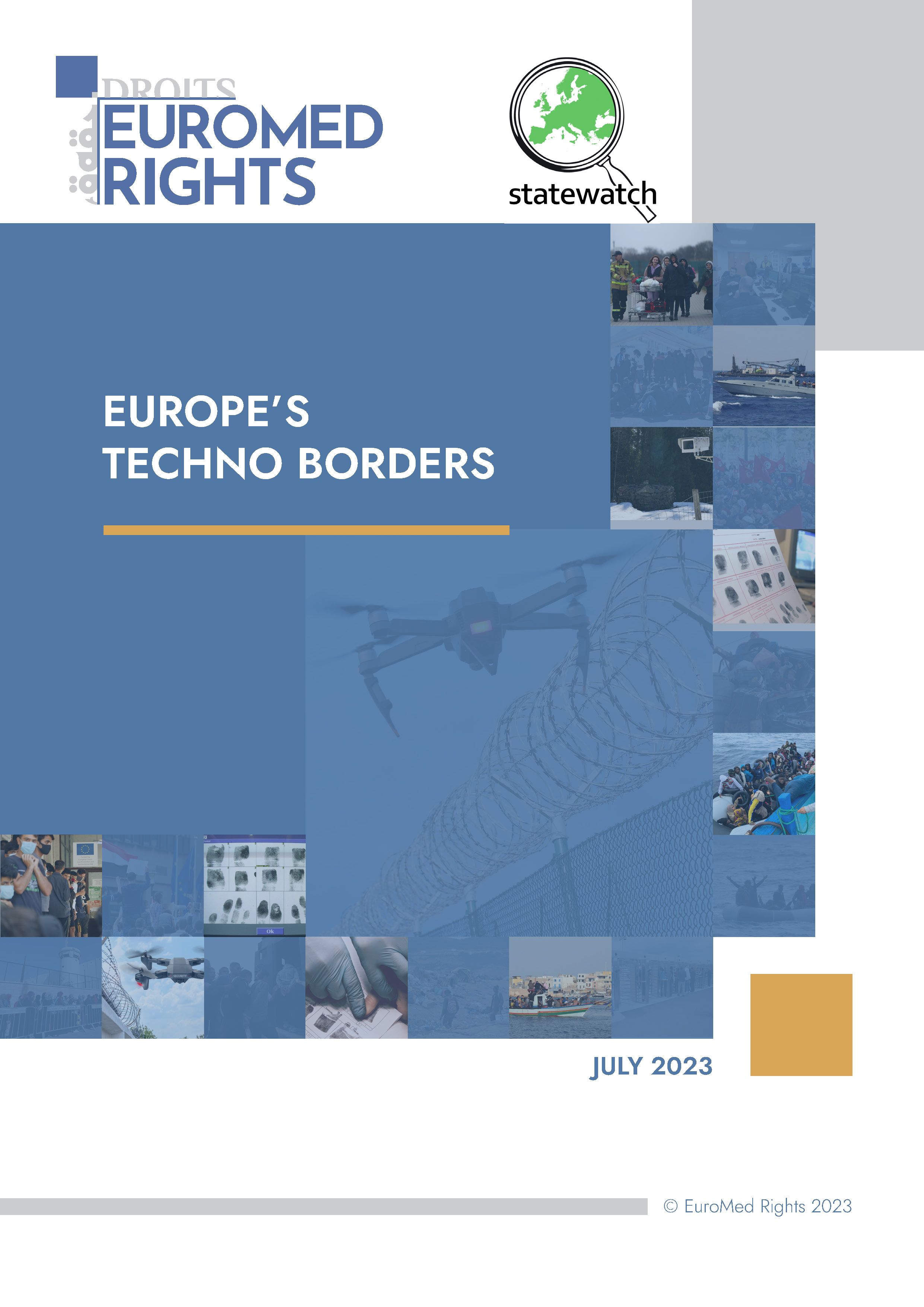Europe's techno-borders
Topic
Country/Region
10 July 2023
The digital technologies deployed as part of Europe’s techno-borders underpin invasions of privacy, brutal violations of human rights, and make the border ‘mobile’, for example through the increased use of biometric identification technologies, such as handheld fingerprint scanners. This report analyses the past, present and future of Europe’s “techno-borders,” the infrastructure put in place over the last three decades to provide authorities with knowledge of – and thus control over – foreign nationals seeking to enter or staying in EU and Schengen territory.
Support our work: become a Friend of Statewatch from as little as £1/€1 per month.
The use of new technologies is fundamental to EU’s system of border control and migration management. This report (pdf), published with EuroMed Rights and launched at an online event on 10 July, explores their development and deployment over the last three decades, during which time an extensive infrastructure of surveillance systems, databases, biometric identification techniques and information networks has been put in place to provide state authorities with knowledge of – and thus control over – foreign nationals seeking to enter EU or staying in Schengen territory. Digital technologies underpin invasions of privacy, brutal violations of human rights, and make the border ‘mobile’, for example through the increased use of mobile biometric identification technologies, such as handheld fingerprint scanners used by police and border authorities.
On the one hand, new technologies are deployed to facilitate the movements of “bona fide” travellers. In the years to come, tourists and businesspeople will be required to hand over increasing amounts of personal information to EU and member state authorities in exchange for being granted entry to the EU. That information will then be used to train algorithms that will be applied to new applications to enter the bloc, in order to assess the level of risk or threat posed by individuals (and, where that level is deemed too high, to deny them the ability to travel to the EU).
On the other hand, new technologies are deployed to detect, deter and repel refugees and migrants seeking to enter EU territory through irregular journeys. Drones, cameras, social media monitoring, satellite imagery and networks of sensors form part of an elaborate surveillance architecture that is being continually extended. Those who do manage to enter EU territory – which is to say, if they are not illegally pushed back by EU authorities, or prevented from leaving a “third country” – are also biometrically registered and screened against a multitude of national and international databases. If they are deported, international data-sharing systems are increasingly being used to facilitate that task.
These techno-borders are backed up by vast quantities of public funding – both for the development of new technologies, and then their subsequent deployment. EU budgets run in seven-year cycles – currently, from 2021 to 2027. Compared to the previous budgetary period (2014-20), the total size of the budgets that will contribute to EU border policies has increased by 94% - although not the entirety of each of those budgets will be used for those purposes. Nevertheless, billions of euros are set to be spent on extending and entrenching Europe’s techno-borders in the years to come.
Figures provided in this report give some indication of which borders are likely to be more substantially reinforced. From 2014 to 2020, the Greek authorities received almost €977 million from the EU’s home affairs funds, dealing with policing; borders; and asylum and integration. In the 2021-27 period, that amount has been increased to just over €1.5 billion. The funding directed specifically towards borders has skyrocketed from almost €303 million to more than €1 billion – an increase of 248%.
This is not the only vast increase. France is to receive almost 200% more from the borders budget than it did in the 2014-20, obtaining nearly €207 million; Croatia will receive almost 100% more, obtaining €155 million; and Spain’s share will increase by 34%, to some €325 million. Other Mediterranean member states, however, have seen substantial decreases in border funding: Malta will receive 45% less than in the 2014-20 period; Cyprus 40% less; and Italy’s share of the borders budget has increased by just 1%, to €315 million. Nevertheless, combined with the budgets for policing and asylum, every Mediterranean member state is to receive more between 2021 and 2027 than in the previous budgetary period.
While these funds can be used to extend surveillance systems, set up connections to the EU’s vast biometric databases, and purchase new equipment and gadgets for border authorities, public funding is also used to develop new border technologies. Through its security research programme, the EU has invested in automated lie detectors to be deployed at border crossing points, the development of automated border control gates, systems using “big data” to try to predict migration movements, and swarms of drones for border surveillance.
This report shows that between 2014 and 2022, the EU has provided more than €250 million to 49 projects seeking to develop border technologies. Think tanks and research institutes feature prominently amongst top 20 entities that have benefited from that funding. Indeed, the Greek Center for Security Studies (€12.8 million), France’s Commissariat à l'énergie atomique et aux énergies alternatives (€8.4 million), TNO from the Netherlands (€4.5 million), Germany’s Fraunhofer Institute (€4.4 million) and the Centre for Research and Technology Hellas (€4.3 million) make up the top five. They are joined by a range of private companies, two universities, and even the NATO Science and Technology Organisation.
The use of, and demand for, new technologies for border and migration control is likely to increase substantially in the coming years, as demonstrated by the final two sections of this report. The first looks at upcoming legislation that will play a role in reinforcing Europe’s techno-borders: the Eurodac Regulation, the Screening Regulation, changes to the Schengen Borders Code, and the Artificial Intelligence Act. These four measures are all currently under debate in the Council of the EU and the European Parliament, and have substantial implications for the rights of migrants and refugees. Those implications may also extend to non-white EU citizens and residents: the changes to the Schengen Borders Code, for example, look likely to encourage profiling operations within EU territory in the name of tracking down irregular migrants.
The final section of the report combs through a series of reports and studies commissioned by the European Commission, Frontex and the EU’s Joint Research Centre in recent years. These have covered the potential uses of artificial intelligence, surveillance technologies and biometrics for border and migration control purposes.
None of them proposes any substantial change in EU policies in these areas. Rather, they set out ways to refine, optimise and intensify the use of existing systems – for example, through the use of new types of biometric identification systems, the further extension of border surveillance systems, and the integration of automated systems into all manner of procedures and processes. Many of the changes proposed do not require specific changes to legislation, and instead are presented as technical issues that merely require the right mixture of funding and management to be implemented effectively. In this manner, they may well escape any substantial public and political scrutiny.
There has of course been significant scrutiny of the EU’s migration policies ever since the signing of the Maastricht Treaty in 1992, and even more so from 2015 onwards. While the question of new technologies has never been absent from the conversation, it often plays something of a background role.
However, the use of new technologies for migration and border control – the development of techno-borders – not only presents substantial challenges for the protection of human rights in and of itself. It also creates certain ‘path dependencies’ that have substantial influence over future developments, as demonstrated by the proposals outlined in the last section of this report for ever more invasive and intrusive forms of biometric identification. The development of techno-borders is also a source of substantial potential profits for private companies, who themselves have a vested interest in the wider deployment of surveillance, identification and information systems. The development of techno-borders, the influence they have on future policy developments, and the industry lobby that surrounds them, requires continuous, close and critical investigation as part of the broader struggle to implement humane migration and asylum policies.
Our work is only possible with your support.
Become a Friend of Statewatch from as little as £1/€1 per month.
Further reading

Telling the story of EU border militarization
Addressing and preventing European border violence is a huge but necessary strategic challenge. This guide offers framing messages, guiding principles, and suggested language for people and organisations working on this challenge. It emerges from a process of discussion online and in-person between over a dozen organisations working in the European migrant justice space.

Frontex and interoperable databases: knowledge as power?
The EU’s border agency, Frontex, will be able to access vast quantities of data once the EU’s ‘interoperable’ policing and migration databases are fully operational. This briefing considers the agency’s use of data from two different perspectives – operational and statistical – and provides an overview of the agency’s role in the EU’s emerging “travel intelligence” architecture. It is aimed at informing understanding, analysis and critique of the agency and its role, with a view to making it possible to better understand, engage with and challenge future developments in this area.

Access denied: Secrecy and the externalisation of EU migration control
For at least three decades, the EU and its Member States have engaged in a process of “externalisation” – a policy agenda by which the EU seeks to prevent migrants and refugees setting foot on EU territory by externalising (that is, outsourcing) border controls to non-EU states. The EU’s New Pact on Migration and Asylum, published in September 2020, proposed a raft of measures seeking to step up operational cooperation and collaboration in order to further this agenda.
Previous article
Frontex and interoperable databases: knowledge as power?
Next article
Spotted an error? If you've spotted a problem with this page, just click once to let us know.
